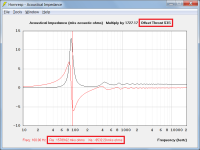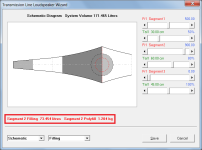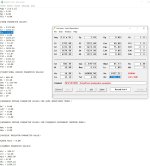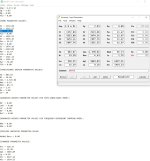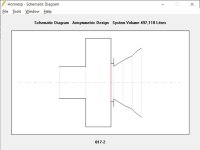Steve, love ya work!
FYI - you can export your modelled response and overlay it onto your measured response by importing it into your measurement software.

FYI - you can export your modelled response and overlay it onto your measured response by importing it into your measurement software.

Hi,
Does anyone know how to go about simulating a horn with two HPs, it's for an ALTEC 817 ?
THANKS
Does anyone know how to go about simulating a horn with two HPs, it's for an ALTEC 817 ?
THANKS
Does anyone know how to go about simulating a horn with two HPs, it's for an ALTEC 817 ?
Hello, the link below has the answer you need.
https://freeloudspeakerplan.rf.gd/?i=1
Hello Lordsansui,
Thanks for your message.
I downloaded your freecad plans for the ALTEC-2 which matches what I have.
But do you also have to download the "hornresp" files?
I will therefore only have to change the T&S parameters of the loudspeaker.
it will allow me to see which news speakers is best suited!
Thanks for your message.
I downloaded your freecad plans for the ALTEC-2 which matches what I have.
But do you also have to download the "hornresp" files?
I will therefore only have to change the T&S parameters of the loudspeaker.
it will allow me to see which news speakers is best suited!
Last edited:
Hello jpvoit, welcome.But do you also have to download the "hornresp" files?
There is a tutorial session with some videos were you can learn, you can skip some of them and focus the ones you need more.
You can use the built-in spreadsheet to copy data from freecad to Hornresp or you can export txt (See automation Level 1 and 2 videos)
The model is flexible and parametric so you can change dimensions if needed and Hornresp input will update accordly and automaticly.
There is one thread to provide support, see the link below, I'm having free time issue but i can try to support you if needed.
https://www.diyaudio.com/community/...loudspeakers-plan-hornresp-integrated.391237/
Hornresp Update 5460-230621
Hi Everyone,
CHANGE 1
Alterations to bandpass type loudspeaker system Pmax and Xmax values can now be permanently saved even though the bandpass loudspeaker wizard itself does not have a Maximum SPL feature. This modification was prompted by Post #13,605 from stv.
CHANGE 2
Sampled acoustical impedance values are now given in mks ohms rather than cgs ohms, and the point at which the impedance is calculated is now more clearly indicated in the chart header. Attachment 1 refers.
CHANGE 3
Absorbent filling material volumes for the total system and individual segments are now shown in the loudspeaker wizard. Double-clicking the Filling label switches between total volume and segment volume values. Attachment 2 refers.
CHANGE 4
Selecting 'Compare Previous' / 'Compare Captured' / F4 now adds the comparison traces to all six main charts, not just to the one currently being displayed.
BUG FIX
The bug reported in Post #13,631 has now hopefully been fixed. My thanks to deanznz for the feedback.
Kind regards,
David
Hi Everyone,
CHANGE 1
Alterations to bandpass type loudspeaker system Pmax and Xmax values can now be permanently saved even though the bandpass loudspeaker wizard itself does not have a Maximum SPL feature. This modification was prompted by Post #13,605 from stv.
CHANGE 2
Sampled acoustical impedance values are now given in mks ohms rather than cgs ohms, and the point at which the impedance is calculated is now more clearly indicated in the chart header. Attachment 1 refers.
CHANGE 3
Absorbent filling material volumes for the total system and individual segments are now shown in the loudspeaker wizard. Double-clicking the Filling label switches between total volume and segment volume values. Attachment 2 refers.
CHANGE 4
Selecting 'Compare Previous' / 'Compare Captured' / F4 now adds the comparison traces to all six main charts, not just to the one currently being displayed.
BUG FIX
The bug reported in Post #13,631 has now hopefully been fixed. My thanks to deanznz for the feedback.
Kind regards,
David
Attachments
Hi Lordsansui,
I downloaded the ALTEC817.zip file and the .txt file.
But I don't know where to put them.
Can you give me a quick tutorial to help me use it quickly.
At first, I only want to change speakers, 515, JBL, etc...
I downloaded the ALTEC817.zip file and the .txt file.
But I don't know where to put them.
Can you give me a quick tutorial to help me use it quickly.
At first, I only want to change speakers, 515, JBL, etc...
Can you give me a quick tutorial to help me use it quickly.
Sure, but this thread is related to Hornresp software and you are asking for help for different subject. It might be better to post in the thread I shared with you at post # 13646.
you can save the file anywhere you want.
The extension *.FCStd has the CAD file, the one you will open thought FreeCAD software
The extension *.FCMacro is the macro, you can change settings inside FreeCAD to change default folder for macro files
The extension *.png are just images with model information to make it easy for the user to remember what model they downloaded, it also serve as reference while modifying the model.
The original A800 VoTT and its later 815, 817 variants have a 55 Hz flare frequency, exponential flare factor, but since they have a parallel pair of walls it's technically a parabolic flare factor, hence HR's breaking it down into slant board expansions for a most technically correct sim, so kudos to DMB for this acoustically relatively minute attention to detail. 👍 😎
That said, if for a HIFI/HT app, there's some audible advantage to using the 825, 828 flared horn design (along with some extra bracing, damping), which can be simmed with its 'close enough' exponential curvature to compare, though of course more woodworking intensive.
That said, if for a HIFI/HT app, there's some audible advantage to using the 825, 828 flared horn design (along with some extra bracing, damping), which can be simmed with its 'close enough' exponential curvature to compare, though of course more woodworking intensive.
I think there must be an error in the dimensions of the pavilion, because it is not straight in reality, it opens more and more!
I don't know the source of the Hornresp design shown, but the Altec horn should be modelled as a single exponential flare segment, rather than being approximated by multiple parabolic segments.
The original A800 VoTT and its later 815, 817 variants have a 55 Hz flare frequency, exponential flare factor, but since they have a parallel pair of walls it's technically a parabolic flare factor
Just to clarify, the flare would be parabolic if the top and bottom were flat parallel panels and the sides were angled flat panels, so that the cross-sectional area expanded linearly. The Altec horn has flat angled top and bottom panels with the side panels being curved to make the overall area expansion rate exponential.
Yeah, thanks, had total brain fade, lately been dealing with folks wanting simple 1, 2 cut segmented approximations for BLHs, front loaded prosound apps.
This file is meant to be imported from File -> Import -> Hornresp Record. That will save you a lot of typing, get all the info into the right places, and avoid errors like the one you saw.I'm moving very slowly, but I'm moving forward.
I downloaded the 817-2.zip file, and I was inspired by a .txt file that I copied into "hornresp".
But it gives me an error!
Can you guide me?
Thanks,
I put the txt file in Hornresp's "import" folder, and it looks more correct!
Is this also your opinion?
I would have thought that it was enough in the software, to enter the starting surface (the throat), then the exit (the mouth), and indicating the length of the pavilion, for this to work well. But apparently, we have to do it piece by piece?



Is this also your opinion?
I would have thought that it was enough in the software, to enter the starting surface (the throat), then the exit (the mouth), and indicating the length of the pavilion, for this to work well. But apparently, we have to do it piece by piece?
Can someone explain to me what S5 and S6 correspond to since the numbers are identical?
It's a shame that on the image of the "shematic diagram", we don't find the labels S1, S2, etc., it would be more understandable to understand the correspondence.
Last question, is the bass-reflex represented by the volume of the left part on the image below?
And in "input parameters" we find it where, it is to be able to modify its agreement "Fb"?
Thank you all again for your support.

It's a shame that on the image of the "shematic diagram", we don't find the labels S1, S2, etc., it would be more understandable to understand the correspondence.
Last question, is the bass-reflex represented by the volume of the left part on the image below?
And in "input parameters" we find it where, it is to be able to modify its agreement "Fb"?
Thank you all again for your support.
- Home
- Loudspeakers
- Subwoofers
- Hornresp
